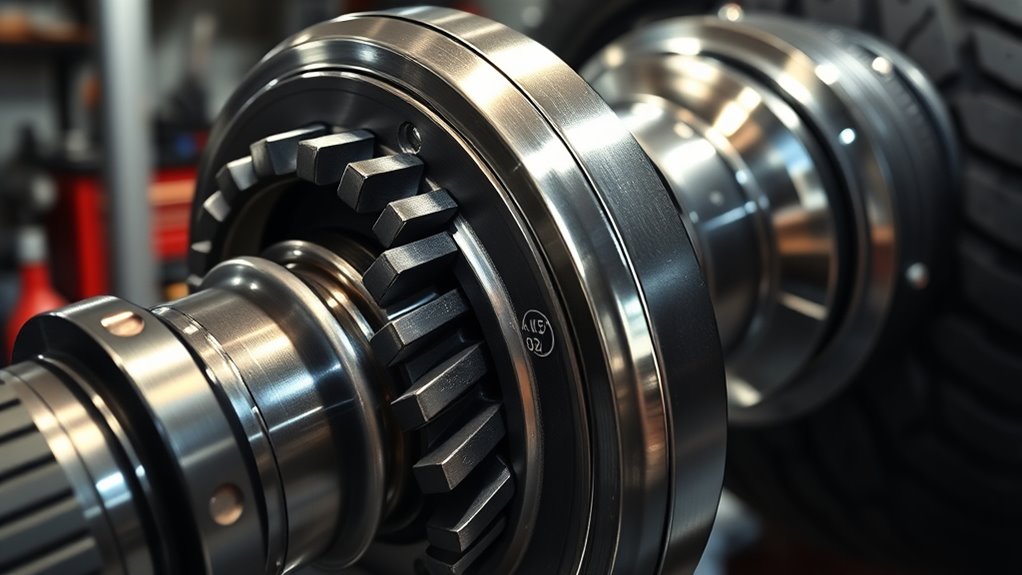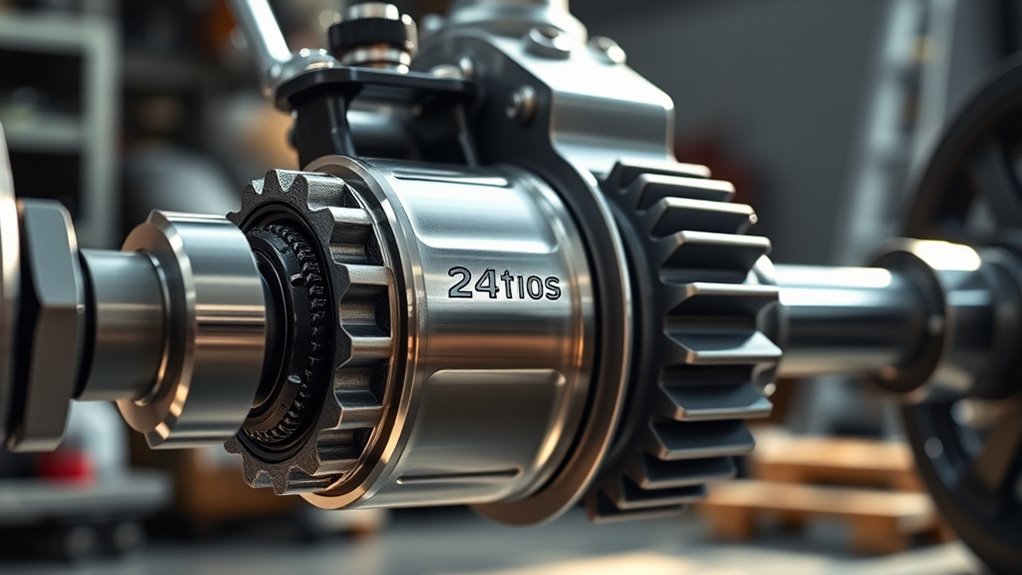Your rear axle ratio plays a key role in how your vehicle performs by controlling how many times your wheels turn per driveshaft rotation. A higher ratio, like 4.10, gives you quicker acceleration and better towing power but uses more fuel at highway speeds. A lower ratio, such as 3.55 or 3.08, offers improved fuel efficiency and smoother highway cruising. Understanding this balance helps you optimize your vehicle’s performance—if you continue exploring, you’ll discover more about choosing the right ratio for your needs.
Key Takeaways
- Higher numerical ratios (e.g., 4.10) increase acceleration and torque but reduce fuel efficiency at highway speeds.
- Lower ratios (e.g., 3.08, 3.55) improve fuel economy and top speed but may decrease responsiveness during acceleration.
- The rear axle ratio determines how many wheel turns occur per driveshaft rotation, directly affecting vehicle performance.
- Selecting the appropriate ratio depends on primary use, such as towing for higher ratios or highway cruising for lower ratios.
- Proper ratio choice balances power, efficiency, and vehicle longevity, enhancing overall driving experience based on needs.

Have you ever wondered how your vehicle’s rear axle ratio affects its performance? This ratio, which compares the number of times the driveshaft turns for each rotation of the wheels, plays a vital role in how your vehicle accelerates, handles, and consumes fuel. When you look under the vehicle or check your owner’s manual, you’ll find a number like 3.55 or 4.10. That’s the gear ratio, and it influences everything from towing capacity to fuel efficiency.
If you opt for a higher numerical ratio, such as 4.10, you’re selecting a gear that turns the wheels more times for each turn of the driveshaft. This means your vehicle will accelerate faster and feel more responsive, especially at lower speeds. It’s like giving your vehicle a boost in torque, which is particularly beneficial when you’re hauling heavy loads or towing trailers.
However, this comes with a trade-off: your engine has to work harder at highway speeds, which can lead to increased fuel consumption. You might notice that your miles per gallon decrease, especially on long drives, because the engine is spinning more frequently to keep up.
On the other hand, a lower numerical ratio like 3.08 or 3.55 provides a different set of advantages. These ratios are geared toward fuel efficiency and higher top speeds. Because the wheels turn fewer times per engine revolution, your vehicle can cruise smoothly at highway speeds with less engine effort.
This means better fuel economy and less engine wear over time. But keep in mind, this setup can make your vehicle feel less lively when you press the accelerator, especially if you’re carrying a load or trying to accelerate quickly from a stop. The lower ratio sacrifices some torque for improved efficiency and higher cruising speeds.
Choosing the right rear axle ratio depends heavily on what you primarily use your vehicle for. If towing or hauling is a regular task, a higher ratio will serve you better. But if most of your driving involves commuting or highway cruising, a lower ratio is more economical.
Additionally, selecting the appropriate axle ratio can impact your vehicle’s overall performance and longevity, especially if you frequently engage in demanding driving conditions.
It’s a balancing act between power and efficiency. Understanding how this ratio works helps you make informed decisions when customizing your vehicle or choosing a new one. Remember, the right rear axle ratio can make your driving experience more tailored to your needs, whether that’s pulling heavy loads or saving on fuel.
Frequently Asked Questions
How Do Rear Axle Ratios Impact Fuel Economy?
A higher rear axle ratio can decrease your fuel economy because it makes the engine work harder at highway speeds, leading to increased fuel consumption.
Conversely, a lower ratio improves efficiency by reducing engine load, helping you save on gas.
If you frequently drive long distances or want better mileage, opt for a lower ratio.
However, if you prioritize acceleration or towing, a higher ratio might be better despite the fuel trade-off.
Can Changing the Rear Axle Ratio Improve Towing Capacity?
Yes, changing your rear axle ratio can boost your towing capacity, turning your truck into a more powerful beast. By adjusting the gear ratio, you give your engine more leverage, like adding muscle to a champion.
This change helps your vehicle handle heavy loads better, making towing smoother and safer. Just remember, higher ratios can slightly reduce fuel efficiency, so weigh your needs carefully before making the switch.
What Is the Best Rear Axle Ratio for Off-Road Use?
For off-road use, you should opt for a rear axle ratio around 4.10 or higher. This setup provides better torque and crawling power, helping you navigate tough terrain.
If you want more control and responsiveness, go for even higher ratios like 4.88.
Keep in mind, these ratios lower fuel efficiency but markedly improve your off-road traction and capability.
Choose a ratio based on your specific terrain and performance needs.
How Does Axle Ratio Affect Acceleration and Top Speed?
A lower axle ratio boosts your acceleration because it allows your engine to spin the wheels faster, giving you quicker starts.
However, it reduces your top speed and can lower fuel efficiency.
Conversely, a higher axle ratio limits acceleration but increases top speed and fuel economy.
You should choose based on whether you prioritize quick starts or higher top speeds, depending on your driving needs.
Are Aftermarket Axle Ratios Reliable and Easy to Install?
You’ll find aftermarket axle ratios like seasoned sailors steering new waters—reliable with proper guidance. They’re generally dependable, especially when sourced from reputable brands, and can boost your vehicle’s performance.
Installation might feel like a dance—challenging but manageable with the right tools and know-how. If you’re comfortable with mechanical work, you can handle it yourself; otherwise, a professional mechanic can make it smooth sailing.
Conclusion
Understanding rear axle ratios helps you fine-tune your ride for better performance and efficiency. Think of it like choosing the right gear for a vintage bicycle—too high, and you strain; too low, and you spin out. By selecting the proper ratio, you’ll enjoy smoother acceleration and ideal fuel economy. So, whether you’re cruising down the highway or towing your vintage camper, making the right choice is like having a trusty sidekick—always ready for the adventure ahead.









